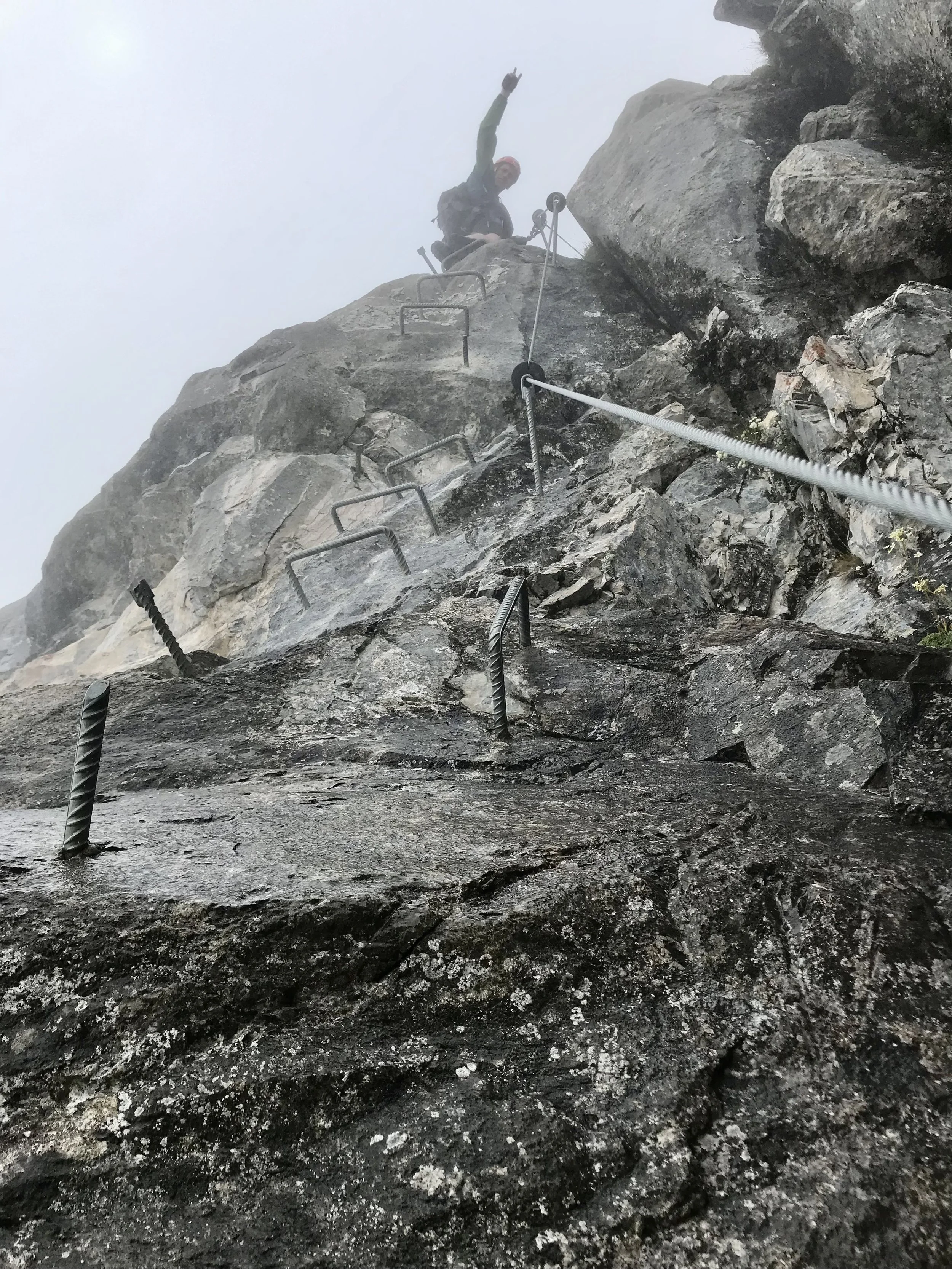Something About Fear
Published by The Royal College of Psychiatrists. Available in text and audio.
Ruminating pointlessly over the minutiae of a lost relationship, I trudged up a slope of broken rock in the Schwyzer Alps. The route was Cameron’s choice. My brother had defended his PhD thesis in Zürich two days prior and this was his chosen celebration.
We reached the foot of the climb and slipped into harnesses, donned helmets, double-checked karabiners, and clipped onto the first length of the fixed cable.
Iron pins and hand hooks were hammered into a route on the Dachstein in Austria in 1843 and experiments proceeded from there. Permanent lines were fixed in the Dolomites through World War I to permit soldiers passage across mountain faces in harsh conditions.
Steel cables and metal rungs have since replaced ropes and wooden ladders. Mostly courses feel safe.
That morning the rock was wet. Swiss via ferrata routes place fewer holds than elsewhere in the Alps, leaving climbers to rely on rock rather than metalwork for grip. This is one thing in the dry but we climbed inside a cloud over wet rock and I wore black running shoes so flimsy they resembled plimsoles. Within minutes I slipped and cut my knee on the gneiss. My blood mixed with water on the rock.
I wondered why I was finding it so tricky. I was out of practice, sure, but had grown up crossing Highland ridges and climbed via ferrata routes around Cortina and Annecy without much trouble. Cameron explained halfway up that our route was rated K5, meaning ‘very difficult…only suitable for experienced and highly skilled climbers…long exposure to heights’.
Within the first pitches I became conscious that my legs were shaking. It was a rattling, involuntary, twitch-tremble-never-rest type of shake. I could climb, but it didn’t feel great. Higher up on an especially long overhung section with a lot of air beneath me I felt my strength fade. My pulse quickened. I began to hyperventilate. Had the cliff been then a mirror I would have seen my pupils dilate and my face blanche. I was afraid.
I knew on one level that were I to slip the harness and karbiners would keep me on the wire. The shock absorber would deploy, my fall would be caught and slowed. Then I would slam into the wall. This part concerned me because all the rungs and spikes which I had used to scale the cliff would in a moment become cudgels and bayonets. I looked up but couldn’t see where I was going because of the overhang and the mist. All I was sure of was that I couldn’t down-climb the section we’d ascended.
To be cragfast is to be stuck on a mountain feeling able neither to ascend nor to descend. It is an awful sensation to be stuck in a frightening place, to be trapped. I wasn’t there yet, but my breath quickened again and I veered toward panic.
Recognising the brink, I began to do sensible things. I clipped a third karabiner on a length of fixed cord to a rung, taking the weight off my arms. I pressed my forehead against the cold of the rock. I listened to the cowbells echoing up the wall from the meadow far below. I focused on my breathing In, hold, out-two-three-four.
Five breaths in my mind began to clear. Lactic acid ebbed from my forearms. My legs settled. I knew I was fine. Best of all, the rest of it had washed out with the fear: vain anger, bootless grief, futile regret. I was present in my circumstances. I pulled myself over the nose and climbed past the overhang. I would get there.
There are many ways to be ok. There is a time to sit with ourselves, to listen and be kind to whatever comes. There is a time to cross our arms over our shoulders and tell ourselves it will be alright. There is also a time for fear, for realising like the family in Michael Rosen’s We're Going on a Bear Hunt that we have to go through it.
Fear draws us out of ourselves. The feeling I had on the rock was only a stronger expression of the anxiety-dread-excitement I have felt many times in the changing room before a football match, upon rising for a debate, arriving at a cardiac arrest, or asking someone out. Fear experienced briefly brings focus, a falling away of other noise, even a sweetness. On Eggstock, fear drew all my senses to the angle of my knee, to my brother’s encouragement, to the metallic taste in my mouth, to the smooth, cool rock.
I thought of a girl I see in clinic. When the stress in her life swells it looms over her head like a wave and crashes. She shuts down. She stops speaking to her mum or replying to her friends. She goes to her room and from a hidden place takes a razor. She cuts a line in the skin across her upper thigh. The act requires total focus. Through it, somehow, her desperation washes out.
Huddled with my brothers in a crevice in the face above the overhang I considered that although I had sat with her for hours I may only now have an inkling of her experience when she cuts – the panic, the focus, the release. I wondered if perhaps to reroute this defence against overwhelm she would need something beyond grounding exercises and compassion for herself. Perhaps she needed a way to get out of her head. Perhaps on a bouldering wall or a basketball court or within a choir or on a tightrope she could zero-in and be made safe through complete attention.
From the top we slithered and slipped down the steep reaches of rock, achieved the path which traversed the mountain, and began to run. We were tight for time to make the last chairlift. I was entirely there.
